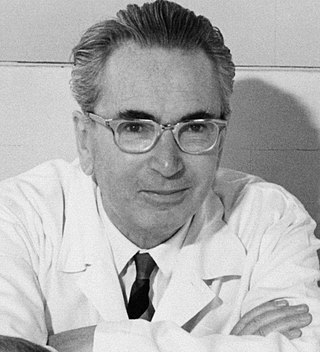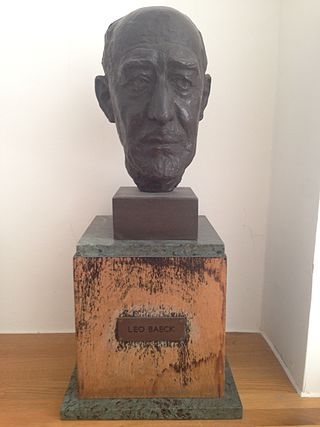Related Research Articles

Viktor Emil Frankl was an Austrian psychiatrist and Holocaust survivor, who founded logotherapy, a school of psychotherapy that describes a search for a life's meaning as the central human motivational force. Logotherapy is part of existential and humanistic psychology theories.

Leo Baeck was a 20th-century German rabbi, scholar, and theologian. He served as leader of Reform Judaism in his native country and internationally, and later represented all German Jews during the Nazi era. After the Second World War, he settled in London, in the United Kingdom, where he served as the chairman of the World Union for Progressive Judaism. In 1955, the Leo Baeck Institute for the study of the history and culture of German-speaking Jewry was established, and Baeck was its first international president. The Leo Baeck Medal has been awarded since 1978 to those who have helped preserve the spirit of German-speaking Jewry in culture, academia, politics, and philanthropy.

Georg Alexander Pick was an Austrian Jewish mathematician who was murdered during The Holocaust. He was born in Vienna to Josefa Schleisinger and Adolf Josef Pick and died at Theresienstadt concentration camp. Today he is best known for Pick's theorem for determining the area of lattice polygons. He published it in an article in 1899; it was popularized when Hugo Dyonizy Steinhaus included it in the 1969 edition of Mathematical Snapshots.

Theresienstadt Ghetto was established by the SS during World War II in the fortress town of Terezín, in the Protectorate of Bohemia and Moravia. Theresienstadt served as a waystation to the extermination camps. Its conditions were deliberately engineered to hasten the death of its prisoners, and the ghetto also served a propaganda role. Unlike other ghettos, the exploitation of forced labor was not economically significant.

George Jiri Brady was a Holocaust survivor of both Theresienstadt (Terezín) and Auschwitz, who became a businessman in Canada and was awarded the Order of Ontario in 2008.

Arnošt Lustig was a renowned Czech Jewish author of novels, short stories, plays, and screenplays whose works have often involved the Holocaust.

Richard Glazar was a Czech-Jewish inmate of the Treblinka extermination camp in German-occupied Poland during the Holocaust. One of a small group of survivors of the camp's prisoner revolt in August 1943, Glazar described his experiences in an autobiographical book, Trap with a Green Fence: Survival in Treblinka (1992).

Theresienstadt. Ein Dokumentarfilm aus dem jüdischen Siedlungsgebiet, unofficially Der Führer schenkt den Juden eine Stadt, was a black-and-white projected Nazi propaganda film. It was directed by the German Jewish prisoner Kurt Gerron and the Czech filmmaker Karel Pečený under close SS supervision in the Theresienstadt concentration camp, and edited by Pečený's company, Aktualita. Filmed mostly in the autumn of 1944, it was completed on 28 March 1945 and screened privately four times. After the war, the film was lost but about twenty minutes of footage was later rediscovered in various archives.

Ilse Weber, née Herlinger, was born in Witkowitz near Mährisch-Ostrau. A Jewish poet, she wrote in German, most notably songs and theater pieces for Jewish children. She married Willi Weber in 1930. She was voluntarily transported to Auschwitz with the children of Theresienstadt and murdered in the gas chambers, along with her son, Tommy. Her most popular book was "Mendel Rosenbusch: Tales for Jewish Children" (1929).
Hans Günther Adler was a German-language poet and novelist, scholar, and Holocaust survivor.
Fritz Weiss was a jazz musician and arranger, active in the first half of the 20th century. He was an organizer of jazz performances and an important participant in the musical life of the Theresienstadt concentration camp. Weiss was murdered in the Holocaust.

The Theresienstadt Papers are a collection of historical documents of the Jewish self-government of Theresienstadt concentration camp. These papers include an "A list" of so-called "prominents" interned in the camp and a "B-list" created by the Jewish Elders themselves. The Theresienstadt papers include two albums with biographies and many photographs, 64 watercolors and drawings from prisoners in Theresiendstadt, and the annual report of the Theresienstadt Central Library. The papers were preserved at the liberation of the camp in May 1945 by Theresienstadt librarian Käthe Starke-Goldschmidt and later loaned to the Altona Museum for Art and Cultural History in Hamburg by her son Pit Goldschmidt. The collection was opened for viewing by the public in 2002 at the Heine Haus branch of the Altona Museum.

Stolpersteine is the German name for stumbling blocks collocated all over Europe by German artist Gunter Demnig. They memorialize the fate of the victims of Nazi Germany being murdered, deported, exiled or driven to suicide. The Stolpersteine in Neratovice, a town in the Central Bohemian Region of the present-day Czech Republic, were collocated in 2010.

The Theresienstadt family camp, also known as the Czech family camp, consisted of a group of Jewish inmates from the Theresienstadt ghetto in Czechoslovakia, who were held in the BIIb section of the Auschwitz II-Birkenau concentration camp from 8 September 1943 to 12 July 1944. The Germans created the camp to mislead the outside world about the Final Solution.

Theresienstadt was originally designated as a model community for middle-class Jews from Germany, Czechoslovakia, and Austria. Many educated Jews were inmates of Theresienstadt. In a propaganda effort designed to fool the western allies, the Nazis publicised the camp for its rich cultural life. In reality, according to a Holocaust survivor, "during the early period there were no [musical] instruments whatsoever, and the cultural life came to develop itself only ... when the whole management of Theresienstadt was steered into an organized course."

Alice Archenhold was a German astronomer whose husband was fellow astronomer Friedrich Simon Archenhold.

The Holocaust in Bohemia and Moravia resulted in the deportation, dispossession, and murder of most of the pre-World War II population of Jews in the Czech lands that were annexed by Nazi Germany between 1939 and 1945.
Anna Hájková is a Czech-British historian who is currently a faculty member at the University of Warwick. She specializes in the study of everyday life during the Holocaust and sexuality and the Holocaust. According to Hájková, "My approach to queer Holocaust history shows a more complex, more human, and more real society beyond monsters and saints."
References
- ↑ Herrmann D.B. (2014). "Archenhold, Friedrich Simon". In Hockey T.; et al. (eds.). Biographical Encyclopedia of Astronomers. New York, NY: Springer. Bibcode:2014bea..book.....H. doi:10.1007/978-1-4419-9917-7. ISBN 978-1-4419-9917-7. S2CID 242158697.; Herrmann, Dieter B. (2014). "Archenhold, Friedrich Simon". Biographical Encyclopedia of Astronomers. pp. 96–97. doi:10.1007/978-1-4419-9917-7_66. ISBN 978-1-4419-9916-0.
- ↑ "Jews in Sports: Jewish Olympic Medalists". Jewish Virtual Library.
- ↑ "Gretchen Metzger". Stolpersteine in Nuremberg (in German). Geschichte Für Alle e.V. - Institut für Regionalgeschichte. Retrieved 2023-07-09.
- ↑ "Auguste van Pels". anne frank house. Anne Frank Stichting. 2018-09-25.
- ↑ O'Connor, JJ & Robertson, EF (August 2005). "Georg Alexander Pick". www-history.mcs.st-andrews.ac.uk. Scotland: University of St Andrews. Retrieved 15 February 2017.
- ↑ Erlanger, Steven (7 March 2002). "Vienna Skewered as a Nazi-Era Pillager of Its Jews". The New York Times.
- ↑ Pnina Rosenberg. "Amalie Seckbach (1870–1944) Biography". Learning about the Holocaust through Art.
- ↑ Flynn, Meagan (April 17, 2018). "How thousands of songs composed in concentration camps are finding new life". The Washington Post . Washington. Retrieved December 1, 2020.
- ↑ "Guide to the Papers of Ilse Blumenthal-Weiss". Leo Baeck Institute. 25 July 2013. Retrieved 17 April 2015.
- ↑ Mark Memmott (24 February 2014). "Oldest-Known Holocaust Survivor Dies; Pianist was 110". NPR . Retrieved 2 March 2014.
- ↑ "Guide to the Papers of Berthold Jeiteles" . Retrieved 10 October 2014.
- ↑ "Jewish Leaders in Czechoslovakia Found Alive, 'Stolyner Rebbe' Murdered by Nazis". Jewish Telegraphic Agency. 27 May 1945.
- ↑ "Arnošt Reiser: Survivor, Émigré, Author, Groundbreaking Chemist". Poly. Retrieved 5 February 2014.
- ↑ Visser, Ellen de (2021-05-03). "Ronald Waterman spreekt na tientallen jaren toch over de oorlog: 'Ik moet getuigen omwille van alle mensen die zijn omgekomen'". de Volkskrant (in Dutch). Retrieved 2021-05-04.